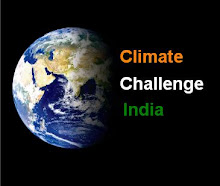Well, after the gloom and doom picture of last week's blog ... Here is some ray of hope.
The causes of the current rate of climate change are anthropogenic (yes, our old friend anthropo = human, genic = caused by).
Therefore, the solutions are also anthropogenic.
I love to say, "anthropoGEnic"!
But seriously, we have to act and make a difference. Our actions have to add up to larger and larger scales (or "levels"). I mean:
Individuals must take action in our own day-to-day lives. To get more and more individuals to do so, we need to communicate with each other and motivate each other to do it. This will help us have a common understanding of the need for cooperation.
Individual action must become collective action. For this, we need to have social, legal, and other ways of doing things. For example, a school may start water harvesting and conservation, reduce or avoid plastics, and recycle 'waste'. This is a collective action (everyone at the school participates) with institutional backing (the school sets climate-affirmative behaviour as its policy).
Administrative structures need to undertake policies for all their work and work environments. This is best if it comes from individuals, through groups, bringing about changes.
Countries have to work within their boundaries and with other countries to reduce their negative (climate-hostile) behaviours / impacts and move to climate-affirmative behaviours / impacts.
The important thing is that all these scales should be connected. No one level should work in isolation. They must all be well-coordinated. This is a tall order! However, we have to make a beginning.
In India, climate-affirmative behaviour is nothing new. We have forgotten many of the good practices of reduce, reuse, and recycle that we used to have.
Simple thing: I remember going to restaurants as a little kid and asking for 2 idlis and 1 vaday to be packed for take away. The food was wrapped in a banana leaf, that packet was then wrapped in newspaper, and tied up with cotton string. No bags were given! I had to have my own bag with me, and a container for sambar. No container = No sambar, tough luck! Look at the amount of plastic that is used so casually for the same order now! Plastic for the idli/vaday, newspaper for the idli/vaday/plastic, plastic for the sambar, and the whole lot put in another very thin plastic bag (the ones that get eaten by cows and cause so many problems for them).
So, here is what each of us need to do in a broad sense. We need to remember the Three-R Mantra (Reduce, Reuse, Recycle). This will get us started. In our own daily lives, we can do a lot of small things. Examples:
Turning off appliances, lightsetc. when not in use.
Turning off the tap while you are brushing your teeth.
As much as possible, pool transportation -- if we drive to work, we could take some colleagues along (yes, yes, share the costs, of course).
Carrying a cloth bag when bying provisions, fruits, veggies, ...
And so on.
Once we start pratising these, we can spread the idea to others quite easily... by telling them, or showing them in practice and drawing their attention to the importance of conservation.
Organizations are doing various things towards becoming more climate-affirmative. Some have rain-water harvesting systems, solar energy appliances, etc. Some are dedicated to the cause of keeping impacts low (see the previous blog where I have mentioned Navadarshanam).
The Government of India has set out a plan for action in its National Action Plan on Climate Change (NAPCC). (This is a large PDF file and will take some time to load!) Under this, several missions are listed that are to develop a coordinated, nationwide effort to reduce our impact on the climate.
The Government of India is also participating in global negotations on how countries can cooperate to reduce climate impacts and slow the rate of climate change. These negotations are very difficult as countries have to think of their own economic progress while also reducing their climate impacts. In December 2009, the countries of the world are to meet in Copenhagen, Denmark to sign a treaty on climate change. This is still very "iffy" at the moment of writing this.
Check back with our portal for updates on these negotations.
You can make a beginning by pledging to do your bit. Take the climate pledge on the CCI portal.
To organize interactive, multimedia workshops for your organization/school/college etc. (in English or Kannada or both), contact me.
"Shabhaash, India!"
Balaji Temple
Chilkuru
Ranga Reddy District
Andhra Pradesh
It's not just cleanliness that is next to godliness...
Climate-affirmative-ness is also next to godliness!
Here is a report on the Chilkuru Balaji temple:
"Chilkur, the home of ‘Visa Balaji’, will soon be ‘plastic-free’, going by a pilot project initiated by the Temple Management Committee making available to thousands of devotees bags made of handloom cloth supplied by APCO." Read more...
You can also read the history of the temple here



No comments:
Post a Comment